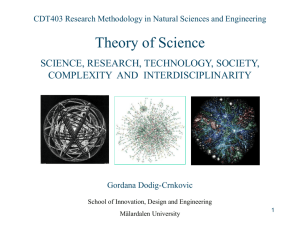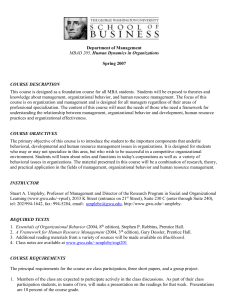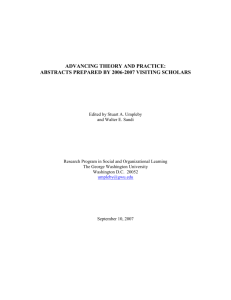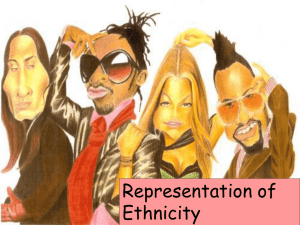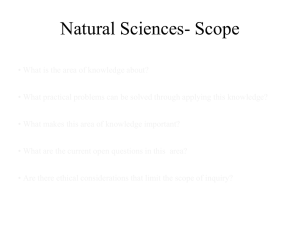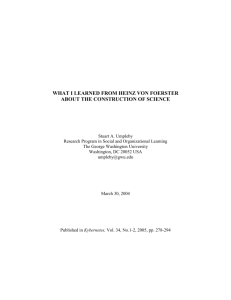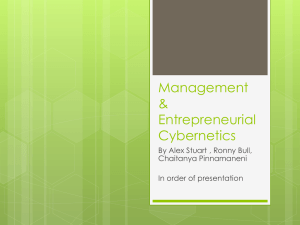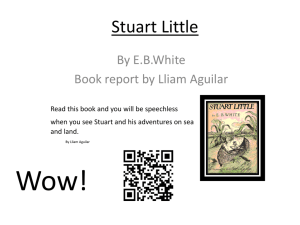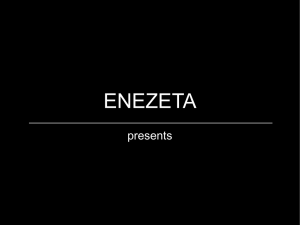lecture3-Worldviews
advertisement
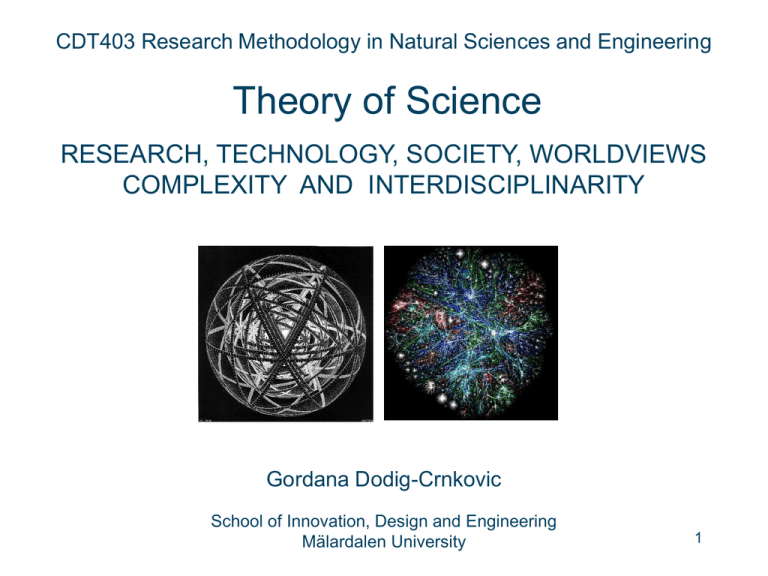
CDT403 Research Methodology in Natural Sciences and Engineering Theory of Science RESEARCH, TECHNOLOGY, SOCIETY, WORLDVIEWS COMPLEXITY AND INTERDISCIPLINARITY Gordana Dodig-Crnkovic School of Innovation, Design and Engineering Mälardalen University 1 Theory of Science Lecture 1 SCIENCE, KNOWLEDGE, TRUTH, MEANING. FORMAL LOGICAL SYSTEMS LIMITATIONS Lecture 2 LANGUAGE AND COMMUNICATION. CRITICAL THINKING. PSEUDOSCIENCE - DEMARCATION Lecture 3 RESEARCH, TECHNOLOGY, SOCIETAL ASPECTS. PROGRESS. HISTORY OF SCIENTIFIC THEORY. POSTMODERNISM . COMPLEXITY AND INTERDISCIPLINARITY Lecture 4 GOLEM LECTURE. ANALYSIS OF SCIENTIFIC CONFIRMATION: THEORY OF RELATIVITY, COLD FUSION, GRAVITATIONAL WAVES Lecture 5 COMPUTING HISTORY OF IDEAS Lecture 6 PROFESSIONAL & RESEARCH ETHICS 2 RESEARCH, TECHNOLOGY, SOCIETY, WORLDVIEWS SCIENCE IN MICROCOSMOS AND IN MACROCOSMOS SCIENCE, RESEARCH, TECHNOLOGY SCIENCE, SOCIETY, ECONOMY – TRIPLE HELIX SCIENCE, RESEARCH, TECHNOLOGY, PROGRESS HISTORY OF SCIENCE THEORY SCIENCE WARS AND PEACE CYBERNETICS AS A LANGUAGE FOR INTERDISCIPLINARY COMMUNICATION TRANSDISCIPLINARY, INTERDISCIPLINARY AND CROSS DISCIPLINARY RESEARCH AN EXAMPLE OF PARADIGM SHIFT IN SCIENCE: COPERNICAN REVOLUTION 3 SCIENCE IN MICRO AND MACROCOSMOS Physical Sciences, Objects and Methods OBJECTS DOMINATING METHOD Simple Reductionism (analysis) Logic & Mathematics Abstract objects: propositions, numbers, ... Deduction Natural Sciences Natural objects: physical bodies, fields and interactions, living organisms ... Hypothetico-deductive method Social Sciences Social objects: human individuals, groups, society, .. Hypothetico-deductive method + Hermeneutics Humanities Cultural objects: human ideas, actions and relationships, language, artefacts… Hermeneutics Complex Holism (synthesis) SCIENCE 4 CLASSICAL SCIENCES HAVE SPECIFIC AREAS OF VALIDITY 5 Different Levels of Organisation – The Structure of Matter 6 DNA - Deoxyribonucleic Acid DNA is the primary chemical component of chromosomes and the material of which genes are made 7 DNA – BASE MOLECULE 8 MOLECULE - ATOM 9 ATOM – NUCLEUS - NUCLEON 10 ELEMENTARY PARTICLES AND FORCES http://www.cpepweb.org/images/chart_2006_4.jpg 11 MODEL vs ”REALITY” http://www.iumsc.indiana.edu/cgi-bin/demoselect.cgi 12 MODELS OF ORGANIC MOLECULES 13 Different Representations of the Same Molecule http://www.iumsc.indiana.edu/graphics/jamm2.1.html 14 IMAGES Santa Cruz scientists have taken a detailed Fluorescence images of rhodamine picture, using x-ray crystallography, of a B molecules obtained by complete ribosome, the small cellular Fluorescence Imaging and component which translates genetic Spectroscopy of Single information into proteins. Molecules http://www.aip.org/physnews/graphics/html/ribosome.html 15 ATOM Images of ultracold rubidium atoms trapped in different configurations of laser beams. Left to right: dual 1-D traps, crossed 1-D traps, and 3-D lattice trap formed at trap intersections. Model of atom http://www.aip.org/mgr/png/Physics News Graphics 16 MODELLING “REAL WORLD” AS IT IS: MODELED SIMPLIFIED MODEL COMPARISON: DOES IT WORK? PHENOMENA COMPARISON “Real world” Program Computer Hardware Model Compiler Theory Computer Simulation 17 MODEL & SIMULATION Rowley's original orrery, 1712. The orrery was made by John Rowley of London for Charles Boyle, fourth Earl of Orrery. The instrument acquired its current name after it was popularized by 17th century essayist, Sir Richard Steele. The solar system model showed the respective motions of the Earth and Moon around the Sun and was copied from an earlier example made by the famous clockmaker George Graham (1673-1713) for Prince Eugene of Savoy. Science Museum London/ Science & Society Picture Library 18 SUN 19 SUN 20 SUN Long-lasting sunspots appear in this sequence of drawings made by Galileo himself as he observed the Sun from June 2nd to 26th, 1612 21 SCIENCE VS TECHNOLOGY The invention of gunpowder, c 14th century. Allegorical interpretation of the invention of gunpowder, showing the devil on the shoulder of a monk involved in an experiment. It is thought that the artist intended the monk in the picture to be Berthold Schwarz, a semilegendary German Franciscan monk. Schwarz was a nickname (German for 'black') due to Berthold's chemical experiments. The picture is an alchemical engraving. Science Museum London/ Science & Society Picture Library 22 TECHNOLOGY EXPANDS OUR WAYS OF THINKING ABOUT THINGS, EXPANDS OUR WAYS OF DOING THINGS. Herbert A. Simon 23 CLASSICAL SCIENCES – LANGUAGE BASED SCHEME Logic & Mathematics Natural Sciences (Physics, Chemistry, Biology, …) Culture (Religion, Art, …) Social Sciences (Economics, Sociology, Anthropology, …) Computing The Humanities (Philosophy, History, Linguistics …) 24 SCIENCES BASED ON SEVERAL RESEARCH FIELDS Our scheme represents classical sciences. Many modern sciences are stretching over several research fields of our scheme. Computer science e.g. includes the field of AI that has its roots in mathematical logic and mathematics but uses physics, chemistry and biology and even has parts where medicine and psychology are very important. 25 WHAT IS AFTER ALL THIS THING CALLED SCIENCE The whole is more than the sum of its parts. Aristotle, Metaphysica 26 SCIENCE, RESEARCH, TECHNOLOGY Aristotle's Distinctions between Science and Technology Science Technology Object unchangeable changeable Principle of motion inside outside End knowing the general knowing the concrete Activity theoria: end in itself poiesis: end external Method abstraction modeling complexity Process conceptualizing optimizing Innovation form discovery invention Type of result law-like statements rule-like statements Time perspective long-term short-term 27 SCIENCE, RESEARCH, DEVELOPMENT AND TECHNOLOGY Research Development Science Technology 28 SCIENCE AND SOCIETY THE TRIPLE HELIX MODEL SOCIETY Knowledge society based on ICT CULTURE SCIENCES & HUMANITIES The triple helix model: – ACADEMIC – INDUSTRY – GOVERMENT 29 SOCIETAL ASPECTS OF SCIENCE Science has undoubtedly several important facets: - insights in foundational issues, - applications - societal aspects. Sciences are promoting rational and analytical discussions of central issues of concern to scientists and other scholars, and to the public at large both in terms of knowledge production and practical applications. 30 SOCIETAL ASPECTS OF SCIENCE RESEARCH COMMUNITY AS INFORMATIONAL NETWORK “ .. if we consider Galileo alone in his cell muttering, ‘and yet it moves,’ with the recent meeting at Kyoto – where heads of states, lobbyists, and scientists were assembled together in the same place to discuss the Earth – we measure the difference ..” Bruno Latour 31 SOCIETAL ASPECTS OF SCIENCE Further reading on current topics: http://www.sciencemag.org Essays on Science and Society Science magazine 32 EVOLUTION OF SCIENTIFIC THEORY (1) Logical Positivism During much of this century, “positivism” has dominated discussions of the scientific method. Positivism recognizes as valid only the knowledge based on experience. 33 EVOLUTION OF SCIENTIFIC THEORY (2) Logical Positivism 1920s: Logical positivism (Vienna Circle), accepted as its central doctrine Wittgenstein’s verification theory of meaning that statements or propositions are meaningful only if they can be empirically verified. This differentiate scientific (meaningful) statements from purely metaphysical (meaningless) statements. 34 EVOLUTION OF SCIENTIFIC THEORY (3) Logical Empiricism Carnap replaced the concept of verification with the idea of “gradually increasing confirmation”. Universal statements could never be verified, but they may be “confirmed” by the accumulation of successful empirical tests. Thus, science progresses through the accumulation of multiple confirming instances obtained under a wide variety of circumstances and conditions. 35 EVOLUTION OF SCIENTIFIC THEORY (4) Logical Empiricism Logical empiricists believe that all knowledge begins with observation. This leads to empirical generalizations among observable entities. As our ideas progress, theories are formulated deductively to explain the generalizations, and new evidence is required to confirm or disconfirm the theories. Throughout the process, data are given precedence. The entire process is viewed as essentially inductive. 36 EVOLUTION OF SCIENTIFIC THEORY (6) Popper and Falsificationism Unlike positivists, Popper accepted the fact that “observation always presupposes the existence of some system of expectations”. For Popper, the scientific process begins when observations clash with existing theories or preconceptions. To solve this scientific problem, a theory is proposed and the logical consequences of the theory (hypotheses) are subjected to rigorous empirical tests. 37 EVOLUTION OF SCIENTIFIC THEORY (7) Popper and Falsificationism The objective of testing is the refutation of the hypothesis. When a theory’s predictions are falsified, it has to be ruthlessly rejected. Those theories that survive falsification are said to be corroborated (= confirmed) and tentatively accepted. 38 EVOLUTION OF SCIENTIFIC THEORY (8) Popper and Falsificationism Thus the problem of induction is seemingly avoided by denying that science rests on inductive inference. Note nevertheless that Popper’s notion of corroboration itself depends on an inductive inference. According to Popper’s falsificationism, science progresses by a process of “conjectures and refutations”. 39 EVOLUTION OF SCIENTIFIC THEORY (9) Popper and Falsificationism The most severe problem with Popper’s version of the scientific method is that it is impossible to conclusively refute a theory because realistic test situations depend on much more than just the theory under investigation. 40 EVOLUTION OF SCIENTIFIC THEORY (10) Kuhn’s Scientific Revolutions Thomas Kuhn (1922-1996) was the one of most influential philosophers of science of the twentieth century. His The Structure of Scientific Revolutions is one of the most cited academic books. His contribution to the philosophy of science meant not only a break with several positivist doctrines but also established a new style of philosophy of science directly related to the history of science. 41 EVOLUTION OF SCIENTIFIC THEORY (10) Kuhn’s Scientific Revolutions Kuhns account of the development of science held that science enjoys periods of stable growth interrupted by scientific revolutions, to which he added the controversial ‘incommensurability thesis’, that theories from differing periods suffer from certain deep kinds of failure of comparability. For Kuhn competing paradigms were incommensurable - they involved looking at the world in radically different ways. Stanford Encyclopedia of Philosophy 42 EVOLUTION OF SCIENTIFIC THEORY (11) Kuhn’s Scientific Revolutions In Kuhn’s view, the individual scientist’s decision to pursue a new paradigm must be made on faith in its “future promise”. Science progresses through “paradigm shifts”, but there is no guarantee that it progresses toward anything - least of all toward “the truth”. 43 EVOLUTION OF SCIENTIFIC THEORY (12) Kuhn’s Scientific Revolutions In criticism of Kuhn, some writers have suggested alternative worldview models as for example “research tradition” concept, which attempts to restore rationality to theory selection by expanding the concept of rationality. 44 Paul Feyerabend: Anything Goes Feyerabend, held that there was no such thing as the scientific method and saw science as an essentially anarchic enterprise in which ‘anything goes’. It is true that there is no single method that marks out science from any other form of rational enquiry but nonetheless there are a range of criteria - such as explanatory scope, predictive power, experimental repeatability, consistency with other wellestablished theory - that make it a different sort of enterprise to, say, astrology or alchemy. 45 POSTMODERNISM Postmodernism is an artistic, architectural, philosophical, and cultural movement which formed in reaction to modernism. Modernism may be seen as the culmination of the Enlightenment's quest for an rational aesthetics, ethics, and knowledge, postmodernism is concerned with how the authority of those ideals, sometimes called metanarratives, are undermined through fragmentation, and deconstruction. 46 POSTMODERNISM Jean-François Lyotard famously described postmodernism as an "incredulity toward metanarratives" (Lyotard, 1984). Postmodernism attacks the notions of monolithic universals and encourages fractured, fluid and multiple perspectives and is marked by an increasing importance in the ideas from the Sociology of knowledge. metanarratives - "grand narratives“, form of ‘universal truth' 47 POSTMODERNISM All knowledge, scientific knowledge included, is held to be socially constructed. Science is therefore merely one story among others. The world we know is one that is constructed by human discourses, giving us not so much truths as ‘truth-effects’ which may or may not be pragmatically useful. From this point of view, epistemologically speaking, a scientific text is understood as being on a par with a literary text. 48 SCIENCE WARS (1) In early 1996 the physicist Alan Sokal created a controversy by publishing two journal articles. The first article, Transgressing the Boundaries: Toward a Transformative Hermeneutics of Quantum Gravity appeared in the journal Social Text. It pretended to be, and was taken by the editors of Social Text as, a serious article on the implications of developments in the field of cultural studies for developments in modern physics, and viceversa. 49 SCIENCE WARS (2) The second article, A Physicist Experiments with Cultural Studies, appeared in the journal Lingua Franca just as issue of Social Text containing the first article came out. It revealed that the first article was in fact a hoax. 50 SCIENCE WARS (3) “But why did I do it? I confess that I'm an unabashed Old Leftist who never quite understood how deconstruction was supposed to help the working class. And I'm a stodgy old scientist who believes, naively, that there exists an external world, that there exist objective truths about that world, and that my job is to discover some of them. “ Allan Sokal 51 SCIENCE WARS (4) “To test the prevailing intellectual standards, I decided to try a modest (though admittedly uncontrolled) experiment: Would a leading North American journal of cultural studies - whose editorial collective includes such luminaries as Fredric Jameson and Andrew Ross - publish an article liberally salted with nonsense if (a) it sounded good and (b) it flattered the editors' ideological preconceptions? “ Allan Sokal 52 SCIENCE WARS (5) The post modern ideas were known as • Deconstructionism • Sociology of Scientific Knowledge (SSK), • Social Constructivism, and they greatly influenced • Science and Technology Studies (STS). The branch of sociology known as Sociology of Scientific Knowledge (SSK) or Science and Technology Studies (STS), had the objective of showing that the results of scientific findings did not represent reality, but were basically the ideology of dominant groups within society. 53 Postmodernist Anti-Scientism Post-modernism was a radical critique against science, contemporary philosophy and current understanding of rationality. The view of science as a search for truths (or approximate truths) about the world was rejected. According to postmodernism, the natural world has a subordinated role in the construction of scientific knowledge. Science was just another social practice, producing ``narrations'' and ``myths'' with basically no more validity than myths. 54 IS THERE ANYTHING NEW UNDER THE SUN? ANY PROGRESS? 55 An Example of Progress - Transports 56 An Example of Progress - Transports Beam me up Scotty next? 57 SCIENCE WARS (6) http://www.physics.nyu.edu/faculty/sokal/ A report from the front of the ``Science Wars'' The controversy over the book Higher Superstition, by Gross and Levitt http://www.math.gatech.edu/~harrell/cult.html http://skepdic.com/sokal.html 58 SCIENCE WARS AND PEACE Cross-disciplinary, multi-disciplinary and interdisciplinary collaboration. Examples: Computing and Philosophy http://ia-cap.org/ http://www.interdisciplines.org Interdisciplines (Topics: Adaptation and Representation, Art and Cognition, Causality, Enaction (Action and perception intertwined), Issues in Coevolution of Language and Theory of Mind, 59 Knowledge Era and Skepticism Again it is almost like in Renaissance, people can claim “Ad fontes” ! To the sources, that is. We do not need to accept a second opinion, we can now try to get a thousand instead , and one can be formidably well informed as a patient. Bodil Jönsson, Think if it is just the opposite!? (Tänk om det är precis tvärtom!?) 60 Cybernetics as a Language for Interdisciplinary Communication Stuart A. Umpleby The George Washington University Washington, DC www.gwu.edu/~umpleby 61 How is interdisciplinary communication possible? • We would need to share a common language • Perhaps there is a common “deep structure” which is hidden by our more specialized discipline-oriented terms and theories Stuart A. Umpleby 62 Common processes in the external world • General systems theory, particularly James G. Miller’s living systems theory, claims that there are certain functions that a living system must perform • Miller suggested that “living systems” exist at seven levels: - cell, - organ, - organism, - group, - organization, - nation, - supranational organization Stuart A. Umpleby 63 3. Basic Concepts In cybernetics there are three fundamental concepts: Regulation Self-organization Reflexivity Stuart A. Umpleby 64 Regulation • Two analytic elements – regulator and system being regulated • Engineering examples – thermostat and heater, automatic pilot and airplane • Biological examples – feeling of hunger and food in stomach, light in eye and iris opening • Social system examples – manager and organization, therapist and patient Stuart A. Umpleby 65 The law of requisite variety • Information and selection – “The amount of selection that can be performed is limited by the amount of information available” • Regulator and regulated – “The variety in a regulator must be equal to or greater than the variety in the system being regulated” W. Ross Ashby Stuart A. Umpleby 66 Coping with Complexity When faced with a complex situation, there are two choices 1. Increase the variety in the regulator: hire staff or subcontract 2. Reduce the variety in the system being regulated: reduce the variety one chooses to control Stuart A. Umpleby 67 The Management of Complexity • There has been a lot of discussion of complexity, as if it exists in the world • Cyberneticians prefer to speak about “the management of complexity” • Their view is that complexity is observer dependent, that the system to be regulated is defined by the observer • This point of view greatly expands the range of alternatives Stuart A. Umpleby 68 Self-organization • Every isolated, determinate, dynamic system obeying unchanging laws will develop organisms adapted to their environments. W. Ross Ashby • Many elements within the system • Boundary conditions – open to energy (hence dynamic), – closed to information (interaction rules do not change during the period of observation) http://www-lih.univ-lehavre.fr/~bertelle/cossombook/cossombook.html Complex Systems and Self-organization Modelling After Stuart A. Umpleby 69 Self-organization 70 Examples of self-organization • Physical example – chemical reactions; iron ore, coke, and oxygen heated in a blast furnace will change into steel, carbon dioxide, water vapor and slag • Biological examples – food in the stomach is transformed into usable energy and materials, species compete to yield animals adapted to their environments After Stuart A. Umpleby 71 Digital Video Feedback and Morphogenesis Video Feedback systems tend toward either stability or chaos. While the stable attractor offers some interest in the subtleties of its decay, the unstable attractor offers an unlimited supply of endless evolving motifs and an emergent behaviour. The system can be get into chaotic emergence via camera movement (rotation and positioning). The important thing was to catch the movement of ‘catching a shape’ in a particular temporal phase to feed back into the system advancing the complexity and initiating lifelike morphogenesis. http://www.transphormetic.com/Talysis01.htm 72 Physical biology of molecular motors involved in intracellular self-organization Motor proteins are key determinants for the spatial organisation of eukaryotic cells. They are thermodynamic non-equilibrium machines playing a crucial role for the dynamic nature of cellular order. In fact, they provide a paradigm for the concept of intracellular order depending on molecular dynamics. How exactly the collective behaviour of various motors with different kinetic properties drives the organisation of the cytoskeleton is not understood. Network of microtubules and two kinds of motor proteins created by self-organisation in vitro http://www-db.embl.de/jss/EmblGroupsOrg/g_175.html 73 Self-Organizing Systems Resources http://www.calresco.org/links.htm 74 Introduction to Complex Systems by David Kirshbaum Four Important Characteristics of Complexity: • Self-Organization • Non-Linearity • Order/Chaos Dynamic • Emergent Properties Computer Programming approaches used for demonstrating, simulating, and analyzing these characteristics of Complex Systems: • Artificial Life • Genetic Algorithms • Neural Networks • Cellular Automata • Boolean Networks http://www.calresco.org/links.htm 75 Examples of self-organization Large-scale lattice Boltzmann simulations of complex fluids: advances through the advent of computational grids Institute for Computational Physics. Physics on High Performance Computers http://www.ica1.uni-stuttgart.de/publications/2005/HCVC05/ 76 Structure and dynamics of animal social networks Interactions between agents (whatever they may be) can be represented by a network. In animal social systems the nodes represent individual animals and the lines between them social ties. There is a growing interest, among mathematicians, statistical physicists, sociologists and others in understanding and characterizing the structure of such networks, and the dynamics of processes (such as the transmission of disease or other "information") on networks. Most of the animal social networks constructed so far are built via an accumulation of many surveys of the population. An alternative approach is to monitor interactions in real time, to try to understand not only how information might be transmitted through a network, but also how the nature of the information might be having an effect on the structure of the network. http://people.bath.ac.uk/pysrj/ 77 Supramolecular chemistry and selfassembling molecules Supramolecular chemists are now extending their research beyond the design of molecules that can be used for molecular recognition or catalysis. They are actively exploring systems that undergo self-organisation - systems that can spontaneously generate welldefined functional supramolecular architectures by self-assembly from Molecular fragments self-assemble to form a dynamic library of their components. potentially bioactive compounds This spontaneous but controlled formation of nanoscale architectures could be "Self-organisation by selection takes advantage of dynamic used to engineer and process diversity to allow variation in response to internal or external functional nanostructures, offering a factors in a Darwinian fashion." powerful alternative to nanofabrication, going from "Constitutional dynamic chemistry paves the way towards an adaptive construction to self-construction. and evolutive chemistry, a further step towards unravelling the science of complex matter." http://www.rsc.org/Publishing/ChemScience/Volume/2007 /02/A_natural_selection.asp 78 Self-reference Reflexivity 79 http://www.lsd.ic.unicamp.br/~oliva/guarana/docs/design-html/node2.html Computational Reflection Douglas Hofstadter on Self-Reference “Self-reference is ubiquitous. It happens every time any one says “I” or “me” or “word” or “speak” or “mouth”. It happens every time a newspaper prints a story about reporters, every time someone writes a book about writing, designs a book about book design, makes a movie about movies, or writes an article about selfreference. Many systems have the capability to represent or refer to themselves somehow, to designate themselves (or elements of themselves) within the system of their own symbolism. Whenever this happens, it is an instance of self-reference.” “My proposal [...] is to see the “I” as a hallucination perceived by a hallucination, which sounds pretty strange, or perhaps even stranger: the “I” as a hallucination hallucinated by a hallucination.” (I Am a Strange Loop, p. 293 ) 80 Self-reference (Reflexivity) • This model has traditionally been avoided and is logically difficult • Inherent in social systems where observers are also participants, in individual living organisms • Every statement reveals an observer as much as what is observed After Stuart A. Umpleby 81 Examples of reflexivity – recursive algorithms This graph is based on a simple recursive algorithm. Recursion is a popular technique used to describe trees and the like, because of the self-referential nature of a tree. Self-reference can lead to undecidability (and paradoxes like set of all sets that are not members of themselves) 82 Observation Self-awareness Stuart A. Umpleby 83 Reflexivity in a social system Stuart A. Umpleby 84 Ideas Variables Groups Events A reflexive theory operates at two levels Stuart A. Umpleby 85 Adaptation/Reactivity/Regulation, Self-organization, Self-reference/Reflexivity/Recursiveness Models of regulation, self-organization, and reflexivity – can be used in two ways, to: • develop descriptions of some system (develop interdisciplinary models), or • guide efforts to influence some system Stuart A. Umpleby 86 Overview of Cybernetics • The focus of attention within cybernetics has changed from engineering to the biology of cognition to social systems • Ideas from cybernetics have been used in computer science, robotics, management, family therapy, philosophy of science, economics and political science • Cybernetics has created theories of the nature of information, knowledge, adaptation, learning, self-organization, cognition, autonomy, and understanding Stuart A. Umpleby 87 Author Von Foerster Pask Varela Umpleby Umpleby First Order Cybernetics Second Order Cybernetics The cybernetics of observed systems The purpose of a model Controlled systems Interaction among the variables in a system Theories of social systems The cybernetics of observing systems The purpose of a modeler Autonomous systems Interaction between observer and observed Theories of the interaction between ideas and society Definitions of First and Second Order Cybernetics Stuart A. Umpleby 88 Engineering Cybernetics Biological Cybernetics Social Cybernetics The view of epistemology A realist view of epistemology: knowledge is a “picture” of reality A biological view of epistemology: how the brain functions A pragmatic view of epistemology: knowledge is constructed to achieve human purposes A key distinction Reality vs. scientific theories Realism vs. Constructivism The biology of cognition vs. the observer as a social participant The puzzle to be solved Construct theories which explain observed phenomena Include the observer within the domain of science Explain the relationship between the natural and the social sciences What must be explained How the world works How an individual constructs a “reality” How people create, maintain, and change social systems through language and ideas A key assumption Natural processes can be explained by scientific theories Ideas about knowledge should be rooted in neurophysiology. Ideas are accepted if they serve the observer’s purposes as a social participant An important consequence Scientific knowledge can be used to modify natural processes to benefit people If people accept constructivism, they will be more tolerant By transforming conceptual systems (through persuasion, not coercion), we can change society Three Versions of Cybernetics 89 Stuart A. Umpleby The Cybernetics of Science NORMAL SCIENCE Correspondence principle Incommensurable definitions SCIENTIFIC REVOLUTION Stuart A. Umpleby 90 The Correspondence Principle • Proposed by Niels Bohr when developing the quantum theory • Any new theory should reduce to the old theory to which it corresponds for those cases in which the old theory is known to hold • A new dimension is required Stuart A. Umpleby 91 New philosophy of science Old philosophy of science Amount of attention paid to the observer An Application of the Correspondence Principle Stuart A. Umpleby 92 TRANSDISCIPLINARY, INTERDISCIPLINARY AND CROSS DISCIPLINARY RESEARCH Modern sciences are stretching through several classical fields. Computer science e.g. includes the field of AI that has its roots in mathematical logic and mathematics but uses physics, chemistry and biology and even has parts where medicine and psychology are very important. Examples: Environmental studies, Cognitive sciences, Cultural studies, Policy sciences, Information sciences, Women’s studies, Molecular biology, Philosophy of Computing and Information, Bioinformatics, adaptive systems, intelligence, consciousness, societies of minds, .. 93 TRANSDISCIPLINARY, INTERDISCIPLINARY AND CROSS DISCIPLINARY RESEARCH Research into complex phenomena has led to an insight that research problems have many different facets which may be approached differently at different levels of abstraction and that every knowledge field has a specific domain of validity. This new understanding of a multidimensional many-layered knowledge space of phenomena have among others resulted in an ecumenical conclusion of science wars by recognition of the necessity of an inclusive and complex knowledge architecture which recognizes importance of a variety of approaches and types of knowledge. 94 TRANSDISCIPLINARY, INTERDISCIPLINARY AND CROSS DISCIPLINARY RESEARCH Based on sources in philosophy, sociology, complexity theory, systems theory, cognitive science, evolutionary biology and fuzzy logic, Smith and Jenks present a new interdisciplinary perspective on the self-organizing complex structures. They analyze the relationship between the process of self-organization and its environment/ecology. Two central factors are the role of information in the formation of complex structure and the development of topologies of possible outcome spaces. 95 TRANSDISCIPLINARY, INTERDISCIPLINARY AND CROSS DISCIPLINARY RESEARCH The authors argue for a continuous development from emergent complex orders in physical systems to cognitive capacity of living organisms to complex structures of human thought and to cultures. This is a new understanding of unity of interdisciplinary knowledge, unity in structured diversity, also found in (Mainzer). 96 “Cosmic evolution leads from symmetry to complexity by symmetry breaking and phase transitions. The emergence of new order and structure in nature and society is explained by physical, chemical, biological, social and economic self-organization, according to the laws of nonlinear dynamics. All these dynamical systems are considered computational systems processing information and entropy.” 97 “Are symmetry and complexity only useful models of science or are they universals of reality? Symmetry and Complexity discusses the fascinating insights gained from natural, social and computer sciences, philosophy and the arts. With many diagrams and pictures, this book illustrates the spirit and beauty of nonlinear science. In the complex world of globalization, it strongly argues for unity in diversity.” 98 ix Preface Part I The Simple and the Complex 1 Prologue: An Encounter in the Jungle 2 Early Light 11 3 Information and Crude Complexity 23 4 Randomness 43 5 A Child Learning a Language 51 6 Bacteria Developing Drug Resistance 63 7 The Scientific Enterprise 75 8 The Power of Theory 89 9 What Is Fundamental? 10 7 3 99 Part II The Quantum Universe 10 Simplicity and Randomness in the Quantum Universe 123 11 A Contemporary View of Quantum Mechanics: Quantum Mechanics and the Classical Approximation 135 12 Quantum Mechanics and Flapdoodle 167 13 Quarks and All That: The Standard Model 177 14 Superstring Theory: Unification at Last? 199 15 Time's Arrows: Forward and Backward Time 215 100 Part III Selection and Fitness 16 Selection at Work in Biological Evolution and Elsewhere 235 17 From Learning to Creative Thinking 261 18 Superstition and Skepticism 275 19 Adaptive and Maladaptive Schemata 291 20 Machines That Learn or Simulate Learning 307 Part IV Diversity and Sustainability 21 Diversities Under Threat 329 22 Transitions to a More Sustainable World 345 23 Afterword 367 Index 377 101 SCIENTIFIC METHOD CASE STUDY: THE COPERNICAN REVOLUTION – Paradigm shift from medieval astronomy to modern science – Plato has defined five perfect solids corresponding to five elements. – In Aristotle’s physics each element had a natural place in the universe. 102 SCIENTIFIC METHOD CASE STUDY: THE COPERNICAN REVOLUTION The natural place for the Earth was in the center of the universe; for Water on the surface of the Earth, for Air in the region above the surface of the Earth, and for the Fire above the atmosphere. The five Platonic solids tetrahedron = plasma ("fire") octahedron = gas ("air") icosahedron = liquid ("water") hexahedron = solid ("earth") dodecahedron = the fifth element, (the quintessence) 103 ARISTOTELIAN WORLD VIEW (1) Each earthly object would have a natural place in the sub-lunar region depending on the proportion of four elements. All objects on Earth were thought to have natural property to move in strait lines upwards or downwards, towards their natural place. Thus stones have the natural motion straight downwards, towards the center of the earth, and flames have a natural motion straight upwards, striving towards the top of the atmosphere. 104 ARISTOTELIAN WORLD VIEW (2) All motion other than natural motion requires a force. In the second century AD Ptolemy developed within the Aristotelian physics a geocentric astronomical system that specified the orbits of the moon, the sun and all the planets. Ptolemy’s system was held as definite truth during the Antique and Middle Ages. 105 PTOLEMY’S SYSTEM 106 COPERNICAN SYSTEM Figure 2 Copernican system 107 THE COPERNICAN TURN Copernicus (1483-1543) had no alternative for Aristotelian physics, and hence had no strong enough arguments to defend his heliocentric system. Copernicus model was against Aristotelian ideas of earth as natural center of the universe. 108 PROBLEMS WITH THE COPERNICAN SYSTEM (1) • Tower argument (the stone dropped from the top of a tower strikes the ground at the base of the tower, contrary to the hypothesis that the earth is spinning around its axes). • Loose objects on the surface of the earth would be expected to flung from the earth surface in much the same ways stones would be flung from the rotating wheel. • Absence of parallax in the observed positions of the stars 109 PROBLEMS WITH THE COPERNICAN SYSTEM (2) • Mars and Venus, as viewed by the naked eye, do not change size appreciably during the course of the year. • If the earth were moving through the universe one would expect wind blowing all the time… • How to explain that the moon follows the earth on its journey through the universe? 110 GALILEO (1) The new Galileo’s (1564 -1642) mechanics helped to defend Copernican system. An object held at the top of a tower and sharing its circular motion around the center of the earth will continue that motion (because of inertia) along with tower, after it is dropped and will strike the ground at the foot of the tower. 111 GALILEO (2) Galileo proposed the following experiment to show the correctness of the law of inertia. If we drop a stone from the mast of a uniformly moving ship on the sea, the stone will strike the deck at the foot of the mast! Galileo also used telescope to observe celestial bodies. The discovery of the phases of Venus was another Galileo’s contribution to a success of Copernican theory. 112 KEPLER (1) The next major support for Copernicus heliocentric scheme was from Kepler (1571-1630). Kepler discovered the following three (Kepler!) laws of planetary motion. Keplers’s first law LAW 1: The orbit of a planet/comet about the sun is an ellipse with the sun's center of mass at one focus. (That eliminated ad-hoc epicycles from Copernican model). 113 KEPLER (2) LAW 2: Sun sweeps out equal areas in equal intervals of time Keplers’s second law LAW 3: The squares of the periods of the planets are proportional to the cubes of their semi major axes: Ta2 / Tb2 = Ra3 / Rb3 114 NEWTON Utilizing Kepler’s third law, Newton derived the law of gravitation. Gravitational force is directly proportional to masses and inversely proportional to the square of their distance. Constant G is called gravitational constant. 115 WHAT CAN WE LEARN FROM THIS HISTORICAL EXAMPLE? (1) We can conclude that neither inductivists (who claim that laws are "induced" from sets of data) nor falsificationists (who claim that one counter-example can prove theory wrong) can give a satisfactory explanation of Copernican revolution. The Copernican revolution did not take place as a result of a new theory supported by experimental confirmation. 116 WHAT CAN WE LEARN FROM THIS HISTORICAL EXAMPLE? (2) New physical concepts of force, inertia and action on distance did not come in the first place as a result of observation and experiment. 117 WHAT CAN WE LEARN FROM THIS HISTORICAL EXAMPLE? (3) Early formulations of the new theory, involving vaguely formulated novel conceptions, were preserved in spite of apparent falsifications! It was only due to the intellectual effort of a number of scientists developing new physics during several centuries, that the new theory could be satisfactorily justified. 118 WHAT CAN WE LEARN FROM THIS HISTORICAL EXAMPLE? (4) Galileo Galilei devised new mechanic to replace Aristotelian and so remove arguments against Copernicus. He distinguished between the ideas of velocity and acceleration (change of velocity), and asserted that freely falling objects move with a constant acceleration that is independent of their weight. 119 WHAT CAN WE LEARN FROM THIS HISTORICAL EXAMPLE? (5) Galileo denied the Aristotelian claim that all motion requires a force and instead proposed circular law of inertia: A moving body subject to no force will move indefinitely in a circle around the sun at uniform speed. This law of inertia is later on replaced by Newton’s law of inertia. 120 AND AN ILLUSION AT THE END! 121
